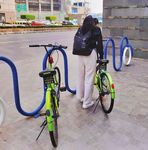Jakarta Is What Resiliency Looks Like
←
→
Page content transcription
If your browser does not render page correctly, please read the page content below
Jakarta Is What
Resiliency Looks Like
By Jemilah Magnusson
and Fani Rachmita
Photos: ITDP Indonesia
For the past several years, the city of
Jakarta, Indonesia, has been on track
for a major transport transformation.
Like most other big cities, Jakarta has
seen soaring growth in the past few
decades, with migrants from all over
the region drawn to the rapidly growing
economy and modern life of the city.
Unfortunately, Jakarta also followed
the lead of most other cities in their
infrastructure priorities: roads and
bridges for cars only, despite the fact
that the majority of Jakartans don’t
own cars. According to Greater Jakarta
Commuter Statistics, less than 10
percent of Jakartans commuted by
private car in 2019, with the much larger
numbers traveling by motorcycle and
transit. Nevertheless, the streets of Fortunately, the city of Jakarta has shown that it is willing and
Jakarta were soon packed with motor able to meet the moment. In the face of major COVID outbreaks
cycles and private cars, and paralyzing and riots against a new labor policy, the city, led by Governor
traffic all but ground the city to a halt. Anies Baswedan, is seeing the benefits of years of work with
ITDP Indonesia.
SHIFTING STREETS TO CYCLING
Much has been made of cities’ major growth in cycling during
the pandemic, and for good reason. Cycling is a fast, cheap,
easily accessible option for city trips that enables the rider to
avoid crowds, and adds zero pollution. As cities around the
world rushed to add more bikes and more safe routes for
cyclists, Jakarta had a head start, having already planned a
500 kilometer network of cycle lanes throughout the city.
"Seeing the need to restrict the spread of COVID-19, we knew
that Jakarta supports its citizens even further because we had
the foundation laid out already," says Faela Sufa, Southeast
Asia Regional Director, “When the social restrictions were
eased in June, we surveyed a major thoroughfare in the city
center and saw that cycling had jumped by 1,000 percent from
a year earlier. In other areas, it was still up by 500 percent or
more. This has really shown to the city, and the people, the
6 JAKARTA IS WHAT RESILIENCY LOOKS LIKEimportance of cycling to keep the city moving, and that if we
make it possible and easier, people will choose to cycle.”
ITDP Indonesia’s work over the last several years to raise
the profile of cycling in Jakarta has paid off during COVID.
This included hosting forum discussions with the public,
cycling communities, and city officials that resulted in a trial
of 63 kilometers of bicycle routes in 2019. The program
convinced the city to start planning a 500 kilometer protected
bicycle lane, currently projected to begin within the year. ITDP
Indonesia is also conducting events to raise awareness about
cycling with a public discussion, a cycling tour, and cycling-
friendly school activities. ITDP Indonesia released two guides
about cycling and a series of infographics, which are popular
on social media.
The increasing need for cycling and walking during the
pandemic prompted the Jakarta Provincial Government to push
forward some much needed measures. Jakarta provided pop-up
bike lanes in Jenderal Sudirman and M.H. Thamrin Street using
temporary measures such as traffic cones. Due to increasing
demand, an additional 12 kilometers of a pop-up bike lane were
implemented, taking over about half of the car traffic lane. This
lane is used only during morning and evening rush hours, but is
also in place for longer periods on weekends. While this was an
emergency response, the city backed it up with new policy.
During the spring social restrictions, the city of Jakarta issued
Governor Regulation No. 51 of 2020 Article 21 which states: “all
road segments are prioritized for pedestrians and bicycle
transport users as a means of daily mobility for accessible
distances.” With the regulation, pop-up bike lane programs and
providing bike parking became the main elements to accelerate
the city’s vision for a bike-friendly city.
A MOVEMENT FOR CHANGE
The changes on the streets would not have been possible
without ITDP Indonesia’s on-the-ground partnerships and
support from the local community. Together with Bike 2 Work
Indonesia, ITDP launched the Sepeda Berbagi initiative, a
program to collect and make available bicycles for anyone to
use for free, which has been heavily used by essential workers
during COVID. The model is similar to a bike share, with the
Top: Transjakarta, and its
idea of encouraging people to try cycling for the first time.
passengers, has benefited
from having a dedicated bus In fact, the movement is now serving as support for Jakarta’s
lane and pedestrian centered
infrastructure design. small, but growing bike-share system. Initially, only 115 bikes,
Bottom: Jakarta's emergency from sharing operators, were available at 9 stations. The
bicycle lane was enforced
and supported by grassroots program has expanded quickly to 72 stations, most of which
cycling advocates.
are located along 2 major streets and at transit hubs.
sustainable transport JANUARY 2021 7While significant obstacles related to COVID-19 remain, like
police opposition and pending municipal budget cuts, public
support and political will continue to rise. In response, the
Jakarta provincial government is now planning to make the
pop-up bike lane permanent. The bike lane would be two
meters wide with a single direction lane and a buffer zone of
planter boxes. The design is already in the final phase and will
start the construction phase in early 2021. This protected bike
lane would be the first of many protected bike lanes in the
new bike-friendly Jakarta.
A MAJOR MILESTONE ACHIEVED
In 2019, with ITDP's support, the city of Jakarta achieved a
major goal: one million riders per day on Transjakarta. This
was a hard-fought win, achieved through a combination of
service improvements, integration, and enforcement. The city
started with a raft of expansions and improvements before
hosting the Asian Games in 2018, and saw its ridership
numbers climb as a result. Next, they focused on integration,
by formalizing the major fleets of angkots, privately owned
minibuses that are the major provider of transit service in the
villages and neighborhoods throughout the city. Before
integration, inefficient routes, delays, crashes, sexual
harassment, and petty crimes were common occurrences,
discouraging ridership, and leading people to avoid public
transit. Jakarta also opened the first corridor of its new Metro
and light rail systems, which are integrated with Transjakarta.
This significantly expands the reach of the system and sets
the stage for the type of extensive, multi-modal transit system
befitting a city of Jakarta’s size.
Transjakarta went beyond route and fare integration and
mandated changes in the angkot business model to improve
reliability and customer service. Before this change, drivers
were paid per passenger, which incentivized delays as they
waited for buses to fill and dangerous speeds as they rushed
Top: Integration with from stop to stop. Now drivers receive salaries based on
Transjakarta encouraged
angkot operators to make distance traveled, enabling them to keep to a set schedule
improvements, like formalized
routes, no smoking on board,
and route, and follow traffic laws without risking a pay cut.
and anti-sexual harassment They also have full access to the 13 corridors spanning over
policies.
Bottom: An angkot navigates
200 kilometers of dedicated lanes. Significantly, city support
Jakarta's daily traffic. and increased education of police officers have kept these
lanes car-free.
As the world’s cities adjust to a new, temporary normal,
Jakarta has particular incentives for wanting to build back
better. With sea levels rising due to climate change, the island
of Java, where Jakarta is located, is under siege. Before the
pandemic, Jakarta was losing over $4 billion every year in
productivity as a result of traffic, and air pollution became a
major public health problem in this tropical city. Fortunately,
the city has now shown that, even in the toughest of
circumstances, it is committed to improving access and
quality of life for its citizens. If Jakarta keeps moving forward,
it has the potential to become a global best practice in transit
and cycling, inspiring replication in cities throughout the
region, and around the world.
8 JAKARTA IS WHAT RESILIENCY LOOKS LIKEYou can also read






















































